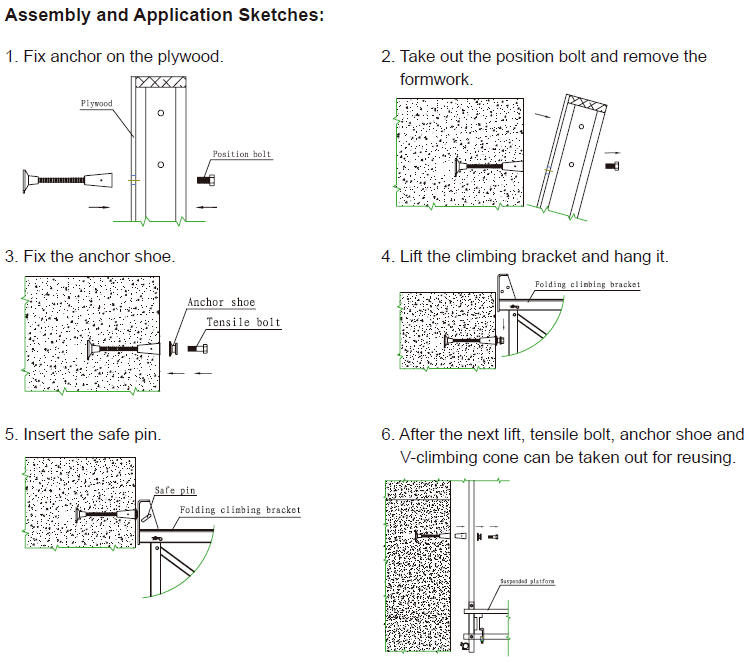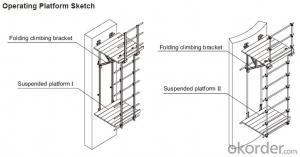Climbing Platform CP 190 for Formwork and Scaffolding systems
- Loading Port:
- Tianjin
- Payment Terms:
- TT OR LC
- Min Order Qty:
- 50 m²
- Supply Capability:
- 1000 m²/month
OKorder Service Pledge
Quality Product, Order Online Tracking, Timely Delivery
OKorder Financial Service
Credit Rating, Credit Services, Credit Purchasing
You Might Also Like
Climbing Platform CP190
Climbing bracket CP190 is mainly used as operating platform during construction. It can be used
on the vertical wall and arced wall. The bracket hang on the anchor system and all the load are
supported by anchor system. It’s convenient to assemble and dismantle, the construction is easy,
rapid and safe.
Anchor System:
Anchor system is the most important supporting part. The system is made of five parts shown
below. There into, tensile bolt, anchor shoe and V-climbing cone can be taken out for reusing.

- Q:Are there any specific building codes or regulations related to steel formwork?
- Steel formwork is subject to specific building codes and regulations that are in place to ensure the safety, stability, and integrity of structures built with this material. The International Building Code (IBC) is one well-known code that sets out minimum requirements for the design, construction, alteration, and maintenance of buildings and structures. It includes provisions for formwork systems, including steel formwork, to ensure they meet standards of strength, durability, and stability. Other organizations and agencies also provide guidelines and standards for steel formwork. For instance, the American Concrete Institute (ACI) has a document called ACI 347-04, Guide to Formwork for Concrete, which offers recommendations for the use of different types of formwork, including steel formwork. These codes and standards cover various aspects of steel formwork, such as design, materials, construction, and inspection. They address issues like maximum allowable loads, proper bracing and shoring, formwork connections, and material quality. They also provide guidance on safety measures, including fall protection, to ensure the well-being of workers during formwork installation and removal. Builders, designers, and contractors must familiarize themselves with these codes and regulations to ensure compliance and guarantee the structural integrity and safety of buildings constructed with steel formwork. Local building departments and authorities having jurisdiction can provide specific information and requirements related to steel formwork in their respective regions.
- Q:Does steel formwork require any special tools for installation and removal?
- Yes, steel formwork typically requires special tools for both installation and removal. Since steel formwork is heavy and rigid, it often necessitates the use of cranes, forklifts, or other lifting equipment to position the formwork panels in place. Additionally, special tools such as spanners, hammers, and wedges are commonly used to secure the formwork panels tightly together and ensure stability during concrete pouring. When it comes to removal, steel formwork usually requires the use of power tools like grinders or cutting torches to disassemble and separate the formwork from the hardened concrete. These tools are necessary to cut through any welds or bolts that hold the formwork in place. It is important to exercise caution and follow safety protocols while using these tools. Overall, due to the heavy and sturdy nature of steel formwork, special tools and equipment are typically required for both installation and removal to ensure efficient and safe execution of the formwork process.
- Q:How does steel formwork affect the overall cost-effectiveness of a construction project?
- There are several ways in which a construction project can benefit from the use of steel formwork, making it a cost-effective choice. Firstly, steel formwork is incredibly durable and can be reused multiple times without experiencing significant wear and tear. This means that there is no need for frequent replacements, resulting in cost savings in terms of materials. Furthermore, steel formwork provides excellent dimensional stability, ensuring precise and accurate construction. This eliminates the need for excessive adjustments and rework, saving both time and money. Additionally, the smooth surface finish provided by steel formwork reduces the need for additional plastering or finishing, further reducing construction costs. Moreover, steel formwork is known for its strength and load-bearing capacity. This allows for larger spans and fewer support beams, reducing the amount of materials required and consequently lowering costs. The structural integrity and stability of steel formwork also contribute to a reduction in the number of labor hours required for installation and dismantling, resulting in labor cost savings. In terms of time efficiency, steel formwork offers quicker assembly and disassembly compared to traditional formwork systems. This can significantly reduce construction durations, leading to cost savings associated with labor, equipment rental, and overhead expenses. Additionally, steel formwork is highly adaptable and versatile, making it suitable for a wide range of construction projects. Its flexibility allows for customization and adjustments to meet project requirements, reducing the need for multiple formwork systems for different construction elements. Overall, the use of steel formwork in a construction project can lead to significant cost savings. Its durability, reusability, dimensional accuracy, reduced finishing requirements, material efficiency, time efficiency, and adaptability all contribute to improved cost-effectiveness. It not only minimizes material and labor costs but also enhances productivity.
- Q:Can steel formwork be used for curved beams and columns?
- Indeed, curved beams and columns can be constructed using steel formwork. This material possesses flexibility and can be effortlessly molded to accommodate the precise curves and shapes demanded by such structures. Moreover, steel formwork boasts exceptional strength and durability, making it ideal for withstanding the considerable weight and pressure exerted by concrete throughout the construction phase. Furthermore, the utilization of steel formwork enables the accurate and meticulous assembly of curved components, guaranteeing that the end result aligns perfectly with the desired specifications.
- Q:Can steel formwork be used for structures with high chemical resistance requirements?
- No, steel formwork is not suitable for structures with high chemical resistance requirements. Steel is prone to corrosion and is not resistant to many harsh chemicals. When exposed to chemicals, steel formwork can deteriorate and lose its structural integrity, compromising the stability and safety of the structure. In such cases, alternative materials like chemically resistant plastics or composites should be considered to ensure the longevity and durability of the structure in environments with high chemical exposure.
- Q:Can steel formwork be used for both interior and exterior concrete elements?
- Steel formwork is suitable for both interior and exterior concrete elements. Its versatility makes it applicable to different construction projects. Furthermore, steel formwork is known for its durability, strength, and ability to withstand the pressure exerted by wet concrete. It also provides exceptional dimensional accuracy and ensures smooth and uniform concrete surfaces. Whether constructing interior slabs, walls, or exterior foundations, columns, or beams, steel formwork is a dependable option for both interior and exterior concrete elements.
- Q:How does steel formwork affect the construction schedule?
- Steel formwork can greatly affect the construction schedule in a positive way. Due to its strength and durability, steel formwork allows for faster and more efficient construction processes. This results in reduced construction time and faster completion of the project. Additionally, steel formwork is reusable, which further saves time and resources as it can be quickly dismantled and used for future construction projects.
- Q:How does steel formwork affect the overall structural integrity of a building?
- Steel formwork plays a crucial role in ensuring the overall structural integrity of a building. It is a temporary mold or framework that is used during the construction process to shape and support concrete until it hardens and gains sufficient strength to bear its own weight and other applied loads. One of the key advantages of steel formwork is its superior strength and durability compared to other types of formwork such as wood or plastic. Steel is known for its high tensile strength and resistance to deformation, which allows it to withstand the pressure exerted by wet concrete without any significant distortion. This strength ensures that the formwork maintains its shape and stability during the pouring and curing of concrete, preventing any potential collapse or failure that could compromise the structural integrity of the building. Moreover, the use of steel formwork provides precise and accurate results in terms of dimension and shape, which is essential for achieving the desired structural integrity. Steel formwork can be fabricated to exact specifications, allowing for tight tolerances and accurate positioning of reinforcement, resulting in a more uniform and robust structure. This precision ensures that the building can withstand various external loads, such as wind, seismic forces, and live loads, without experiencing excessive deflection or deformation. Additionally, steel formwork offers excellent reusability, making it a cost-effective and sustainable option in construction projects. Unlike other types of formwork that may require frequent replacement, steel formwork can be used multiple times, reducing material waste and overall project costs. This reusability also contributes to the structural integrity of the building, as the formwork is less prone to deterioration or degradation over time, ensuring consistent quality and performance. In summary, steel formwork significantly enhances the overall structural integrity of a building by providing superior strength, precision, and durability. Its ability to withstand the pressure of wet concrete, maintain accurate dimensions, and resist external loads ensures the structural stability and safety of the building. Moreover, the reusability of steel formwork offers cost-effective and sustainable advantages, further contributing to the long-term structural integrity of the constructed building.
- Q:How does steel formwork contribute to better site organization?
- Steel formwork contributes to better site organization by providing a durable and reusable system for creating concrete structures. Its accuracy, strength, and ease of assembly allow for efficient and precise construction, reducing the need for on-site adjustments or modifications. This results in a well-organized and streamlined construction process, saving time and resources. Additionally, steel formwork's versatility enables the creation of complex shapes and designs, enhancing the aesthetic appeal of the site.
- Q:What are the advantages and disadvantages of the application of the steel formwork and the plywood formwork in the construction?
- Economic aspect: the steel formwork one-time investment cost is high, but the turnover number is more; the wood template cost is low, but the turnover number is less
1. Manufacturer Overview |
|
|---|---|
| Location | |
| Year Established | |
| Annual Output Value | |
| Main Markets | |
| Company Certifications | |
2. Manufacturer Certificates |
|
|---|---|
| a) Certification Name | |
| Range | |
| Reference | |
| Validity Period | |
3. Manufacturer Capability |
|
|---|---|
| a)Trade Capacity | |
| Nearest Port | |
| Export Percentage | |
| No.of Employees in Trade Department | |
| Language Spoken: | |
| b)Factory Information | |
| Factory Size: | |
| No. of Production Lines | |
| Contract Manufacturing | |
| Product Price Range | |
Send your message to us
Climbing Platform CP 190 for Formwork and Scaffolding systems
- Loading Port:
- Tianjin
- Payment Terms:
- TT OR LC
- Min Order Qty:
- 50 m²
- Supply Capability:
- 1000 m²/month
OKorder Service Pledge
Quality Product, Order Online Tracking, Timely Delivery
OKorder Financial Service
Credit Rating, Credit Services, Credit Purchasing
Similar products
New products
Hot products
Related keywords
























